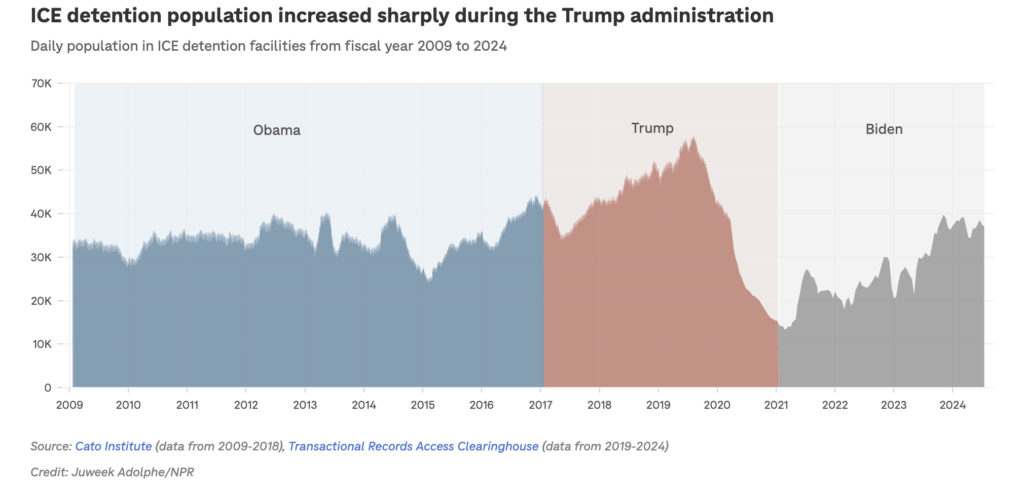Trump touts historic deportation plans, but his own record reveals big obstacles
Documents obtained by NPR show how the Trump administration scrambled to scale up its detention capacity, as well as how bureaucratic hurdles slowed the process.

Attendees at the Republican National Convention hold up signs reading "Mass Deportation Now!" last month in Milwaukee. (Scott Olson/Getty Images)
At the Republican National Convention this summer, hundreds of attendees waved signs demanding “Mass Deportation Now!”
When former President Donald Trump took the stage on the final night of the convention, he promised to launch “the largest deportation operation in the history of our country” if reelected.
Trump’s deportation pledge has become a familiar theme of his 2024 campaign, repeated often by the former president at his rallies, in the official Republican Party platform and in his recent conversation with billionaire X owner Elon Musk.
But the Trump administration’s own track record reveals why that will be difficult, if not impossible, to execute.
Internal emails and documents obtained by NPR through a Freedom of Information Act request offer a window into how immigration authorities scrambled from the first days of the Trump administration to scale up their detention capacity in response to requests from the White House. At the same time, they reveal how bureaucratic hurdles slowed the process, limiting the administration’s ability to ramp up immigration enforcement to match the administration’s rhetoric.
Ambitious enforcement plans for a second term
There are 11 million unauthorized migrants in the U.S., according to the Office of Homeland Security Statistics. Immigration observers say it would be really challenging to remove all of them, particularly because migrants are spread throughout the country and many have lived in the country for decades and have started families.
Unauthorized migrants also fuel the U.S. economy by paying billions of dollars in local and state taxes, the American Immigration Council reported in June.
Still, Trump and running mate JD Vance have pushed for mass deportations and have falsely claimed that up to 20 million unauthorized migrants are living in the United States.
They have not been specific about how they plan to carry out their plan, but at least Vance has recognized it might be challenging.
“You start with what’s achievable,” Vance said in an interview with ABC News that aired Sunday. “You cannot have a border unless you’re willing to deport some people. I think it’s interesting that people focus on, well, how do you deport 18 million people? Let’s start with 1 million.”
But Trump and his allies have talked openly about deporting millions more, including migrants who have been in the country for decades, such as the spouses of U.S. citizens and others whom Biden has tried to shield through executive actions.
Stephen Miller, a former senior adviser for Trump, said in a November interview with the conservative Charlie Kirk Show that Trump’s mass deportation plan “involves building large-scale staging grounds near the border, most likely in Texas, because of the existing infrastructure there.”
Miller is not officially part of the Trump campaign. But during the Trump administration, he had an enormous influence on shaping immigration policy and was behind some of the most hard-line immigration proposals.
He said the facilities would provide space for military aircraft to take unauthorized migrants to Mexico and countries in Asia and Africa. The plan could also include deputizing the National Guards of Republican states as “immigration enforcement officers.”
“That’s the basic idea logistically for how you’re able to carry out a deportation operation at that monumental magnitude,” Miller said.
In an April interview with Time, Trump did not rule out building detention camps as part of his deportation plan.
“I would not rule out anything,” Trump said. “But there wouldn’t be that much of a need for them” because, he said, the plan is to send migrants back to their home countries as quickly as possible.
“We’re not leaving them in the country,” Trump said. “We’re bringing them out.”
In a July call with reporters, Trump said he’d also tap local law enforcement to carry out his plan. Some states, like Texas, have tried to do something similar.
“I’d be using local police,” Trump said. “They know everything about the criminals, and you’d certainly start with the heavyset criminals.”
Throughout his campaign, Trump has suggested that crime rates have increased due to an influx of unauthorized migrants.
“I believe it’s over 20 million people came into our country [under the Biden administration], many coming from jails, from prisons, from mental institutions … and many are terrorists,” Trump said Monday in his interview with X’s Musk.
But it’s not true that 20 million migrants have come under the Biden administration or that they are driving up crime rates. Research shows immigrants are less likely to commit crimes than U.S.-born people, and FBI data shows violent crime has gone down since 2020. There’s also no evidence that countries like Venezuela or El Salvador are emptying their prisons and sending migrants to the United States.
Still, Trump vowed to also use the National Guard to conduct deportations. This proposal has raised eyebrows, since the Posse Comitatus Act does not allow the use of the military to enforce laws within the U.S., except in “cases and under circumstances expressly authorized by the Constitution or Act of Congress.”
To accomplish the mass removal of unauthorized migrants, federal agencies like ICE and the Department of Homeland Security would need more infrastructure and likely more personnel, since there are about 6,000 Enforcement and Removal officers.
Chad Wolf, who served as acting secretary of the Department of Homeland Security under Trump, says more resources would also need to be appropriated.
“I’m sure that the administration will look at how do you bring in more resources to identify folks — how do you target aliens — which ICE already does, in a more thoughtful manner, and how do you expedite their removals,” Wolf said.
Wolf, who is not part of Trump’s campaign, concedes that implementing “mass deportations” would be difficult.
During his administration, Trump fell short on his campaign promise of deporting many people.
“We had a Democratic Congress who did not fund us to the levels that we had asked for and put a lot of restrictions in place,” Wolf said.
But he said now — nearly four years after Trump left office — there are more resources, like infrastructure, that could help the Republican carry out his plan.
Wolf suggested repurposing Biden’s soft-sided facilities, currently used to process migrants, as additional places to detain those who would be deported.
He said deportations can start with people who have committed crimes or who have a final order of removal.
“Is it going to happen overnight? Probably not,” Wolf said. “But I think it’s a worthy debate to have.”
When the Trump administration came to power in 2017, immigration authorities moved quickly to add more detention beds to keep up with the White House’s mandate to increase enforcement.
ICE emails obtained by NPR show how administration officials turned immediately to private detention companies while in search of available beds.
“Here is where things currently stand in response to the recent Executive Orders,” ICE’s Johnson wrote, laying out a plan to add 9,000 additional detention beds through new contracts to be negotiated “immediately.” Another 3,000 beds could be added to existing contracts, Johnson wrote, and 6,000 more could be added in a later round of negotiations if necessary.
The email identified more than a dozen facilities operated by private detention companies, including GEO Group, MTC, CCA (now CoreCivic) and LaSalle Corrections, that could be repurposed or expanded to detain migrants for ICE.
But Johnson also anticipated some of the challenges ahead. In the email, he suggested that ICE staff should try to streamline the agency’s lengthy security clearance process for detention facility staff members.
“See if clearance standards could be temporarily lessened to allow for the immediate onboarding of contract staff while checks are ongoing,” Johnson wrote.
A window into the rapid expansion of ICE detention
Johnson Email by WHYY News on Scribd
ICE’s strategy of seeking additional bed space from private detention companies predates the Trump administration.
In emails from October 2016, months before Trump took office, ICE officials wrote in an email that they were “in dire need for detention beds to respond to an immigration crisis on the Southern border,” and they reached out to private detention companies to discuss available bed space.
“Tempted? Anything that GEO has proposed interests you/ICE?” an ICE detention official wrote to Johnson in an email in September 2016. (That official’s name, like many of the names in the emails and documents NPR obtained, was redacted by ICE attorneys.)
Still, no previous administration had expanded the use of private detention facilities as quickly as the Trump administration.
By February 2017, less than a month after Trump took office as president, ICE had identified more than 30 detention facilities in more than a dozen states, ranging from small county and parish jails to large detention facilities. Many facilities on that list did eventually hold detainees for ICE, though in some cases it took months or even years before the contracts were completed and signed.
“In the government, sometimes it’s designed not to move quickly,” said Ron Vitiello, a former acting ICE director under Trump during 2018 and 2019, in an interview with NPR. “It’s hard to get from where you are to where you want to be in a rapid pace.”
There was additional pressure to add detention space to help move migrants quickly out of short-term holding facilities operated by U.S. Customs and Border Protection, Vitiello said, which were overflowing because of a jump in the number of border apprehensions.
ICE held regular meetings “to figure out what the resource picture looked like, what available beds were out there,” Vitiello said. “It was a full-court press in the sense of seeing what was available that needed new contracting, expanding current contracts.”

- ICE detentions from presidents Obama to Biden. (Juweek Adolphe/NPR/Cato Institute/Transactional Records Access Clearinghouse)
Thousands of detention beds were available to ICE at the time as the Department of Justice phased out the use of private detention facilities and as some states moved to shorter sentences and more frequent use of parole for low-level offenders.
Some facilities, like the Adams County Correctional Center in Natchez, Miss., had formerly held inmates for the Federal Bureau of Prisons. But the Justice Department declined to renew that contract as it scaled back its use of private prisons in 2016.
Other prisons were vacant because of declines in the inmate population in Texas and Louisiana.
In March 2018, a senior vice president at the GEO Group whose name was redacted by ICE wrote to ICE’s Johnson “regarding the availability of our idle 1,000 bed South Louisiana Processing Center” in Basile, Louisiana. The facility could be opened in as little as 45 days, GEO said, as it worked to expedite security clearances for its staff.
Sometimes, local officials approached ICE directly seeking a tenant for their vacant detention space. That was the case in Anson, Texas, a small town about a two and a half hours’ drive from Fort Worth, where county officials had built a prison with the expectation that the Texas Department of Criminal Justice would hold inmates there. But the department pulled out in 2010, leaving the facility vacant for years — until county judge Dale Spurgin called ICE.
“Judge Spurgin had been in contact on prior occasions to see if ICE was interested in using the facility, however funding never allowed ICE to use the facility,” immigration authorities wrote in an internal report explaining the need for the additional bed space. “With the current situation on the border, Judge Spurgin reached out again to see if ICE might be interested in the facility.”
This time, ICE was interested. The Bluebonnet Detention Facility, as it’s known, began holding detainees in late 2019.
Former immigration officials take differing views of Trump’s plans
Trump often speaks admiringly of another former Republican president, Dwight Eisenhower, and his immigration policies. “You know, he was a moderate, but he believed very strongly in borders,” Trump said during his Republican National Convention speech last month.
Still, Trump has avoided using the name of Eisenhower’s most famous mass deportation program on the record.
“Operation Wetback,” as it was known in official government documents, took its name from a racist term for Mexicans who swam or waded across the Rio Grande. In 1954, Eisenhower’s immigration commissioner launched the military-style operation to remove thousands of Mexicans who had crossed into the U.S. in search of work.
Immigration authorities later claimed to have rounded up and removed more than 1 million people. Historians now say that this number may be massively inflated, though there’s little doubt that the operation ensnared many U.S. citizens as well and that hundreds of deportees died during roundups or on ships bound for Mexico.
The modern record for most removals in a four-year span was set during the first term of President Barack Obama, who was labeled the “deporter in chief” by immigrant rights advocates who were critical of his policies. Removals by ICE peaked on his watch in fiscal year 2013, with more than 432,000 in a single year. During the Trump administration, annual removals never exceeded 270,000.
Even the Biden administration, despite widespread criticism from immigration hard-liners, is on pace to carry out roughly the same number of deportations as the Trump administration, according to the nonpartisan Migration Policy Institute — if you combine returns at the border, which have soared under Biden, with removals from the interior. (And that’s without counting the roughly 3 million migrants who were rapidly expelled after crossing the border under pandemic-era rules known as Title 42.)
Still, the former president and his allies promise they can eclipse those records in a second Trump administration.
“It’s 100% possible,” said Vitiello, the former acting ICE director. As few as 55,000 to 60,000 detention beds would be enough to support a larger deportation operation, Vitiello said, if they were paired with border policies that cut down on the number of illegal crossings.
“You can do all of those things at once,” Vitiello said. “But you have to start with the flow now at the border and then set a priority for what happens in the interior.”
This is not the first time Trump has promised massive deportations. When he was president in 2019, Trump tweeted, “Next week ICE will begin the process of removing the millions of illegal aliens who have illicitly found their way into the United States. They will be removed as fast as they come in.”
Next week ICE will begin the process of removing the millions of illegal aliens who have illicitly found their way into the United States. They will be removed as fast as they come in. Mexico, using their strong immigration laws, is doing a very good job of stopping people.......
— Donald J. Trump (@realDonaldTrump) June 18, 2019
Caught off guard, immigration authorities scrambled to make good on those warnings. Meanwhile, immigrant advocates and Democratic leaders in cities across the country vowed to protect unauthorized immigrants in their midst. In the end, no mass arrests or deportations materialized.
Some former ICE officials believe Trump and his allies are once again threatening more than they can deliver when they promise the largest deportation operation in U.S. history.
“The cynic in me would say that’s a political statement, not really a practical statement,” said Saldaña, the former ICE director, that’s designed to appeal to people “who like the idea of coming in and kicking people out of the country.”
In reality, Saldaña says, any effort to remove all the 11 million unauthorized immigrants in the U.S. would face enormous legal and practical challenges.
Many of those immigrants are living in the shadows and have never had any contact with immigration authorities. So even if ICE were able to find and arrest them, they could be entitled to contest their removal before an immigration judge. But that process can take years because of lengthy backlogs in immigration courts.
“It’s a morass of regulations, government cooperation, in order to try to get somebody back into their country,” said Saldaña. “The logistics are not simple.”
Moreover, immigrant advocates say removing millions of unauthorized immigrants at once would have a devastating effect on communities and families — including millions of mixed-status families that include U.S. citizens and lawful residents — and would likely hurt the U.S. economy in the process.
It’s possible that a second Trump administration could choose to focus its enforcement efforts on the more than 2.5 million migrants who’ve been allowed into the U.S. to seek asylum during the Biden administration. Many of them are legally present in the country while they await their asylum hearings in immigration court — though most lack any kind of permanent legal status.
Some of Trump’s allies say those recent arrivals should be taking his threats of mass deportation seriously.
“As a guy who spent 34 years deporting illegal aliens, I got a message to the millions of illegal aliens that Joe Biden released in our country in violation of federal law,” Homan, the former ICE acting director, told a cheering crowd at the Republican National Convention last month. “You better start packing now. You’re damn right. ‘Cause you’re going home.”

Get daily updates from WHYY News!
WHYY is your source for fact-based, in-depth journalism and information. As a nonprofit organization, we rely on financial support from readers like you. Please give today.





